I've recently1 taken a look at Iowa's enlisted mess, but the broader subject of food at sea deserves a look. The challenges of providing and preparing food at sea are quite different from those of doing so on land, particularly before modern developments like canning and refrigeration.
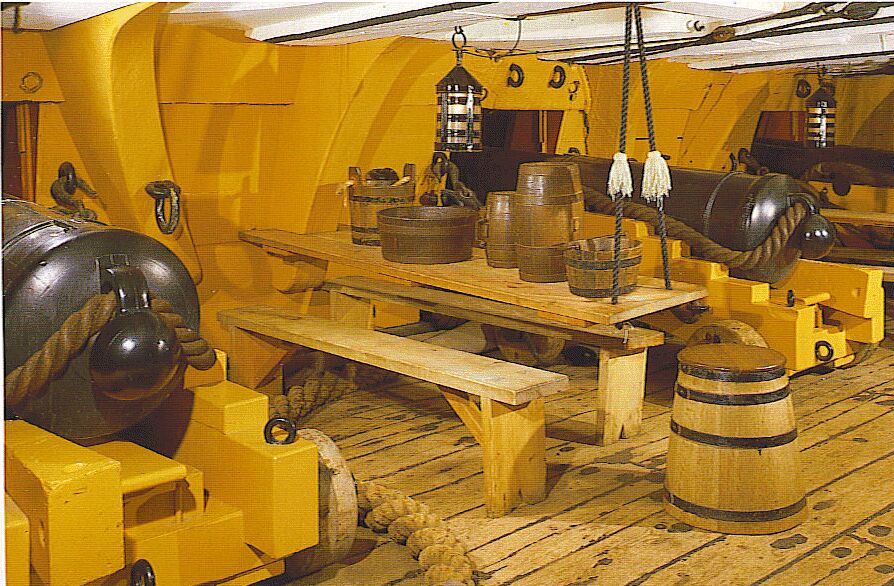
A mess table aboard HMS Victory
During the age of sail, naval rations are generally reputed to be quite bad, but running a sailing vessel is hard work, and malnourished men could not do it effectively. The Royal Navy of the era actually recognized this, and put a great deal of work into providing ample, healthy food for its sailors. The French were less careful about doing so, and their effectiveness at sea probably suffered as a result. British feeding of their sailors was coordinated by the Victualling Board, who operated major industrial enterprises including bakeries, breweries, and slaughterhouses. They were generally honest, setting strict standards for the quality of provisions and carefully auditing the accounts of ship's pursers, who would have their salaries docked if their books were wrong.
The foundation of the naval diet during this era was the ship's biscuit, also known as hardtack, created from flour, water, and a little bit of salt. It was cheap to procure, as unlike the soft breads of the day it didn't require experienced bakers, and could be baked in large batches.2 It would keep for years, particularly if kept dry, and was hard enough that sailors would either soak pieces in some liquid or suck on them over the long term to make them soft enough to eat. Eventually, the biscuit would acquire weevils, and sailors habitually tapped pieces before eating them to drive the weevils out. The standard issue was a pound of biscuit a day.
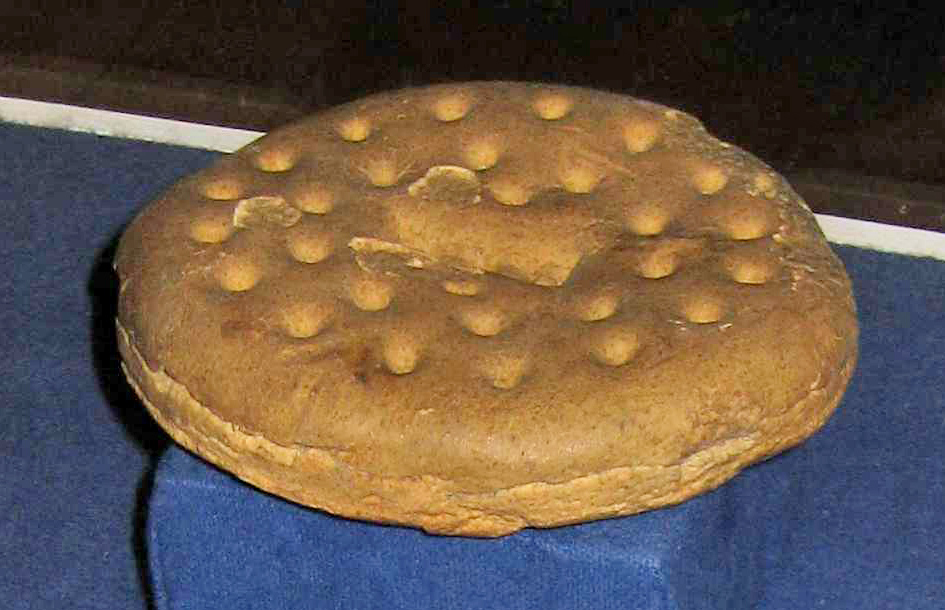
An antique ship biscuit, dating to the 1850s
But sailors couldn't survive on biscuit alone. The preferred method, used when ships were in port or just after they sailed, was to provide fresh meat and vegetables from sources ashore. Live cattle would be loaded aboard, to be slaughtered over the first week or two, but it was after they ran out that the real problem began.3 Navies had to provide foods that could withstand the rigors of storage and handling, both afloat and ashore, and that provided something like a balanced diet, according to the understanding of the time.4
To go with the biscuit, sailors in the RN were issued other food on a standard weekly rotation. On Sunday and Thursday, this was a pound of salt pork and a half-pint of dried peas. Monday was a pint of oatmeal, two ounces of butter, and four of cheese. This was also served on Wednesday and Friday, along with a half-pint of peas. Finally, Tuesday and Saturday usually meant 2 pounds of salt beef. Conventionally, this was washed down with a daily gallon of beer. The total came to approximately 5,000 calories a day, an incredible amount to modern eyes but quite appropriate for sailors at the time. Of course, it wasn't always possible to source this exact menu, and an elaborate table of substitutions was prepared. Some of the beef was usually replaced with suet and flour for pudding, while biscuit could be replaced by rice. Rice could also replace cheese, as could sugar, oil, cocoa, or tea.
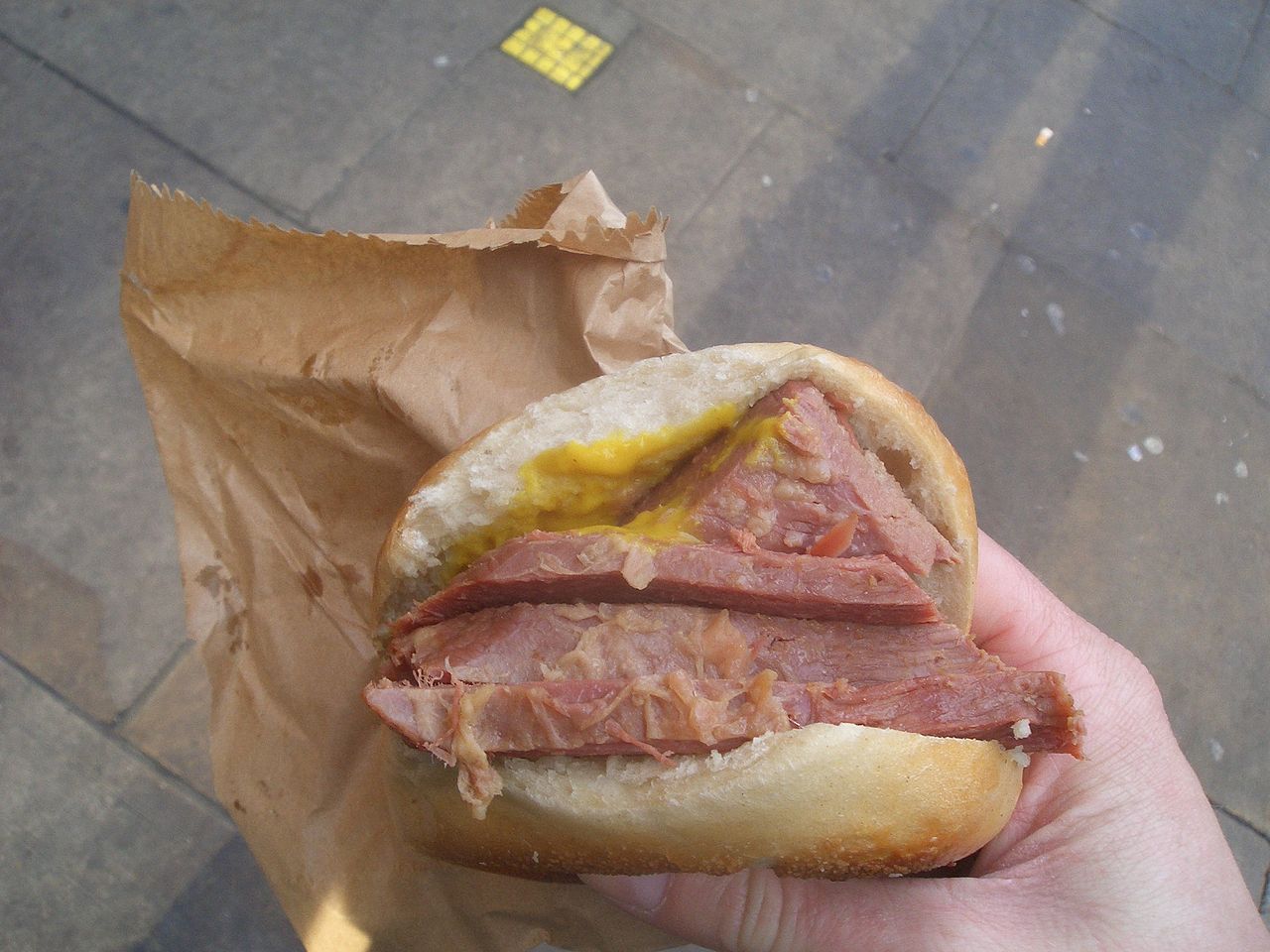
Salt beef. The bagel is not naval-related.
The salt meat produced either in the victualing yards or by private contractors. In either case, the methods were the same. Fresh beef was cut into 4-pound chunks, and pork into pieces half that size, and packed in dry salt. Saltpeter was added, as it was thought to help the salt penetrate the meat, although it also turned the meat bright pink and hardened it over time. After a week, the meat, now heavily dehydrated, was packed with more salt in barrels, which were then filled with strong brine, tested by seeing if the meat floated in it. To prepare it for consumption, the cook would steep the meat in water to reduce the salt content to something actually edible.
The basic unit of cooking and eating was the mess, a group typically made up of four to eight men. Men were typically allowed to choose their own messes, so they usually formed the basis for the sailor's social life. The job of "mess cook" rotated weekly between members of the mess, and the designated man would be responsible for collecting the provisions from the ship's proper cook. Great care was taken to ensure there was no partiality, with the ship's cook stabbing a fork known as a tormentor into the steeping tub without being able to see the meat. The mess cook would then do what limited preparation was necessary, placing the ingredients to be cooked into a bag that was then returned to the ship's cook for boiling.5 The mess cook was also responsible for setting up the mess's table. These were slung between the guns, with benches on either side. The crew usually ate using wooden dishes, as metal was expensive and ceramics were too fragile for use at sea.
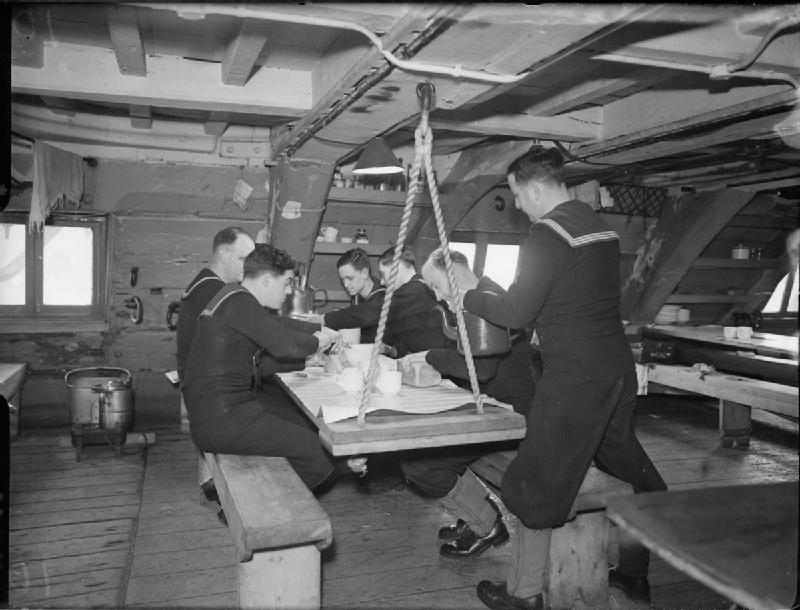
A mess aboard HMS Victory in WWII, similar to those of the age of sail
The ship's cook was not expected to have any culinary skills. He was instead a veteran sailor who had some injury, usually the loss of a limb, that rendered him unfit for normal duty, and was charged with maintenance of the galley equipment, steeping of the meat, issuing food, and having the galley coppers boiling when the mess cooks showed up. Except in rare cases, boiling was the only form of cooking conducted onboard, although this wasn't too different from British cuisine ashore at the time.6
Of course, all of this ignores what the sailors themselves considered the most important part of their diet, the alcohol ration. This was famously rum, also known as grog, but that isn't quite true. The official ration was actually for a gallon of beer per man per day,7 and this was indeed issued in home waters. The problem was that the beer of the day didn't last all that well, particularly when stuck in a barrel in the hold of a ship at sea. So ships on overseas stations would procure alcohol locally. In the Mediterranean, where the RN spent most of its time, the obvious choice was wine, of whatever color happened to be available. For longer deployments or in cases where supplies had to be sourced from far away, spirits were used instead. This could be brandy (in the Med), arrack (in the East Indies) or rum (in the West Indies). Later on, the West Indian merchants lobbied the Navy, and rum became the standard spirit everywhere.
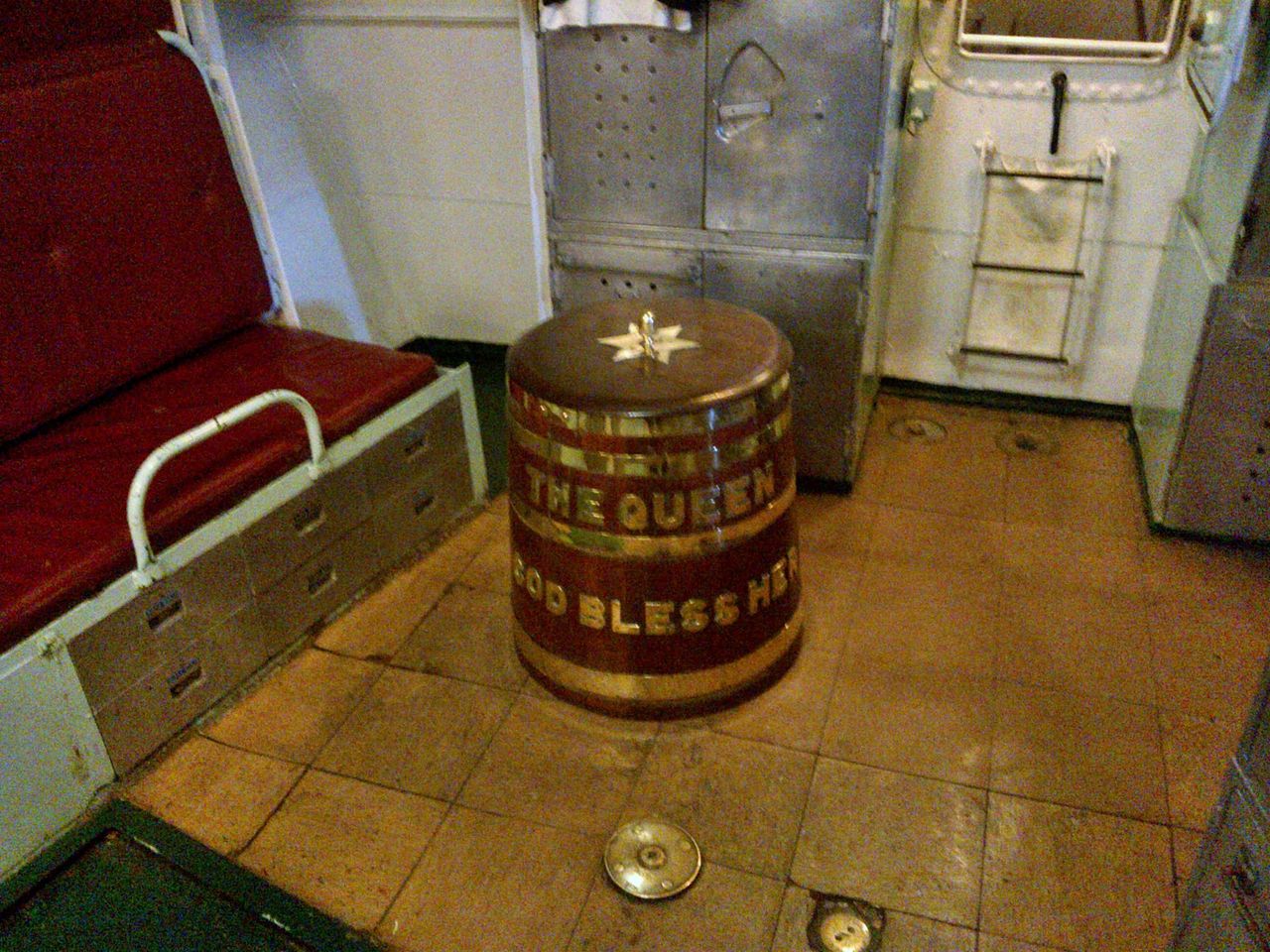
A grog tub aboard destroyer HMS Cavalier
Grog was diluted rum. Until 1740, spirits were served neat, but Edward Vernon, known as "Old Grog" from his habit of wearing a grosgrain cloak, ordered that the half-pint ration be mixed with a quart of water, which he believed would improve the men's health. If nothing else, it made it much harder for the men to hoard their ration and drink several days at once. Sailors who were too young or didn't drink would receive extra pay instead. The pracitice of issuing rum to the RN's sailors continued all the way to 1970, while New Zealand's navy didn't abolish it until 1990.
But all of this covers only the common sailors. Things were rather different for the officers, although in theory they were provided with the same food as their men. In practice, officers took the monetary value of their provisions from the purser instead, and combined it with private funds to buy better food. They also had a dedicated cook who usually actually knew what the word meant, and their own private liquor supplies as well. I'm not going to chronicle the weird world of 18th-century naval food here, but details can be found in the novels of Patrick O'Brian, or the book Feeding Nelson's Navy, one of my main sources for this post.
Next time, we'll take a look at innovations throughout the 19th century, and into the early 20th, which vastly improved the food aboard warships worldwide.
1 Or at least it was recently when I started writing this. ⇑
2 British hardtack was only baked once, contrary to popular belief. ⇑
3 In some cases, particularly long blockades, systems were set up to resupply ships with cattle at sea, but even then, this was not a major part of the diet. ⇑
4 This was obviously before modern nutritional science, and scurvy in particular was common because they didn't get this quite right, but overall, they did a pretty good job. ⇑
5 One of my books indicates that the mess cook was expected to whistle while making a raisin pudding, because this made it impossible to sneak any of the raisins. ⇑
6 Rebecca Friedman would like to register her disagreement with this statement. She points out that other forms of cooking were common in that era, and she knows a lot more about this than I do. I suspect this may be a common/elite divide, but am not really in a position to run it down. ⇑
7 This sounds like a lot, but it was "small beer" of 2-3% alcohol by volume, while most modern beers are in the 4-5% range. ⇑

Comments
How big was a pint pre-1824, 16 Oz?
@Lambert Yes, a pint has always been 16 ounces, but you've forgotten to ask how big the ounce and the sixteen were in old units. :D
A typical British landlubber of the time also drank something like a gallon of beer (of the same 2-3% alcohol content) daily. The reason was that London (and to a lesser extent other cities) had become so densely populated that it was impossible to supply enough ground water from wells to completely satisfy everyone's need. The rivers were the only practical additional source of water, but unprocessed river water (especially from the Thames) wasn't exactly suitable for drinking. Boiling was one common way to purify water, which possibly explains the popularity of tea in England; another was to turn the water into beer. So most people on land didn't drink beer for the alcohol content, but simply because it was the most convenient stuff to drink. Therefore it's somewhat ironic that sailors were given beer specifically because it has alcohol, when they also had to have drinkable water available.
Rum, also known as Grog...
Errr, not quite. Grog was specifically rum mixed with water. Wikipedia has a fair bit of detail.
I wonder to what extent the ship food was influenced by the normal food of a nation. And that those nations where, for example, long, snowy winters meant they had to develop food that lasted for several months of storage, meant that they tended to have a more appropriate selection of rations to use once transoceanic shipping was developed.
The thing you've got to remember about long snowy winters is that food doesn't go off quickly in those conditions either.
Root vegetables can be left in the ground and harvested as needed. Grain can be stored until it needs to be milled.
@Doctorpat
That was intended to be a "in popular culture, it is believed" setup for the following discussion of alcohol. Note the next paragraph down.
@Aula
I think another big factor on mass terrestrial beer consumption was just as a relatively cheap way to store grain and get calories. The book I have on this (The Taste of Empire) claims beer was a major calorie source for working class Englishmen until rising fuel and grain costs in the mid-late 18th century made brewing your own beer unaffordable for most laborers.
However, imported sugar was cheap and so the working classes started to subsist more and more on extremely sugary tea and treacle-covered bread. This had the health effects you'd imagine.
Presumably the navy had the funds to keep procuring beer if they wanted, but interesting they shifted more uniformly to sugar-based drinks at the same time this was happening at home.
At some point after the Napoleonic Wars (can't find exactly when offhand), the West Indies rum lobby managed to get rum made the standard spirit for the RN, and this eventually ended up replacing beer as the standard. Unfortunately, neither my books nor Google are able to shed light on the process. If water supply stops being such an issue, maybe the Navy decides rum is easier to deal with than beer.
This is probably jumping ahead a few generations, but when did fresh water supply not become a constraint? My impression is that onboard de-salination was mostly a WWII or later innovation, but I would also imagine that the end of sail coincided with vessels having enough onboard storage capacity for most domestic fresh water uses,* given how much water the boilers and so on required.
*i.e. drinking/cooking, not necessarily showering
Sailing ships had a lot of water capacity. The big problem was the water going off, which was finally solved towards the end of the Napoleonic Wars when the RN replaced wooden casks with iron water tanks.
But water stopped so much of a problem for a couple of reasons. First, steamships had to stop and take on coal, and where there was coal, there was water. Second, sail was a bit slower and a lot less reliable than steam. With steam, you can say "we'll sail on day X, and get there on day Y" and be pretty confident in Y. Under sail, you might end up on Desolation Island instead.
As for distilling gear, a little bit was fitted even during this era (Victory apparently has an attachment for her galley stove) although the concern there is fuel. It was apparently standard practice to tap condensate from the steam jacket on early steam engines. Proper distillers were first fitted in 1867, but it wasn't until 1884 that double distillers became capable of providing makeup feedwater. Not sure how they did with drinking water, but as engines got higher, they needed cleaner water to avoid issues.
...For what it's worth, there was a series a couple years ago called 'The Terror' that had a surprising amount of detail on just how ships were provisioned in the old days (in this case, the 1840s).
@Gareth, The book I have on this (The Taste of Empire) claims beer was a major calorie source for working class Englishmen
My understanding is that old style beer was much thicker than anything still available. Much more like a grain soup than a modern lager.
Strangely, I've never seen "15th century beer" available, even though old styles of food and wine are growingly fashionable.
That sounds right and I think is discussed somewhere in the book. Not really a big beer drinker myself, which may be a factor, but have a hard time picturing that. There must be some revival recipes out there.
@Rolf Andreassen- an Imperial pint (as you will get if you order a pint of beer in an English pub) is still 20 Imperial fluid ounces.
I can't find any certain information about the number of ounces in a pre-1824 pint, or even which pre-1824 pint the Navy used. Before standardising on Imperial measurements in 1824, the UK used Winchester measure, which had separate gallons for wine, ale and corn. The Imperial gallon, defined as the volume of ten pounds of distilled water at 62 °F, is very close to (but slightly smaller than) the Winchester ale gallon- while the US customary gallon is based on the significantly smaller Winchester wine gallon.
I suspect that, given that the alcohol ration was officially supposed to be beer, the ale gallon (with 20-ounce pints) was used.
I remember seeing the weekly food rations for Dutch sailors posted up in the galley of the replica Dutch East Indiaman at the Scheepvaartmuseum in Amsterdam. IIRC they were reasonably similar to the British ones, except that salt fish replaced some of the meat, and the spirit supplied was jenever rather than rum.
The days in the Royal Navy when no meat was served were called Banyan days. This apparently comes from a caste of Hindu merchants (more commonly spelled as Bania or Vaniya) who were vegetarian.
I don't recall for sure if there is beer served, but at Mount Vernon, George Washington's home in Virginia, there are spirits made to his recipe. Washington would have been roughly contemporary to those on the Victory. Also, a few hours North in Philadelphia, there used to be a tavern there, near Independence Hall, that serves now the same recipes it did in the 18th century.